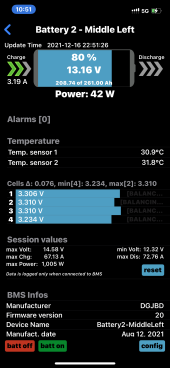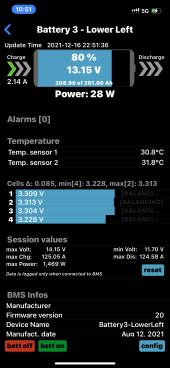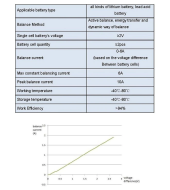TommyHolly
New Member
- Joined
- Jun 24, 2021
- Messages
- 207
Hello,
I re-installed 4 prismatic 300Ah LiFePo4 batteries in my boat a few months ago. Out of the 48 cells, I’ve constructed a 3P 4S system making 4, 300ah batteries at 1,200Ah. (See previous posts)
Each battery has its own Overkill Solar BMS. I’ve noticed that Battery 1 & 4 are constantly getting drained with 25A while Batteries 2 & 3 are actually CHARGING! wity 5A or so?? How can this happen?
All batteries are connected directly to the bus bar so they should all drain equally or all charge equally. Is there a way to connect the Overkill Solar BMS together so that they act as one whole system? It’s strange that two of them are charging while the others are draining…
This leads to a situation where Batteries 1 & 4 will shut off at 0% due to the BMS low voltage limit while Batteries 2 & 3 are still at 70%??? I find myself needing to shut off two batteries so that they drain or charge to balance them manually.
Please see pictures.
I re-installed 4 prismatic 300Ah LiFePo4 batteries in my boat a few months ago. Out of the 48 cells, I’ve constructed a 3P 4S system making 4, 300ah batteries at 1,200Ah. (See previous posts)
Each battery has its own Overkill Solar BMS. I’ve noticed that Battery 1 & 4 are constantly getting drained with 25A while Batteries 2 & 3 are actually CHARGING! wity 5A or so?? How can this happen?
All batteries are connected directly to the bus bar so they should all drain equally or all charge equally. Is there a way to connect the Overkill Solar BMS together so that they act as one whole system? It’s strange that two of them are charging while the others are draining…
This leads to a situation where Batteries 1 & 4 will shut off at 0% due to the BMS low voltage limit while Batteries 2 & 3 are still at 70%??? I find myself needing to shut off two batteries so that they drain or charge to balance them manually.
Please see pictures.
Attachments
-
 D65D26C5-6486-4870-B07C-C4B08ABCB6ED.png563.6 KB · Views: 43
D65D26C5-6486-4870-B07C-C4B08ABCB6ED.png563.6 KB · Views: 43 -
 C6936A86-6D5B-47AE-9AC5-033769EAF6FA.png557 KB · Views: 25
C6936A86-6D5B-47AE-9AC5-033769EAF6FA.png557 KB · Views: 25 -
 84C65105-429E-464C-849A-6F20FC3A23D1.png551.4 KB · Views: 24
84C65105-429E-464C-849A-6F20FC3A23D1.png551.4 KB · Views: 24 -
 5AFD4B25-5857-4A79-B999-056447F16D9F.png554.9 KB · Views: 43
5AFD4B25-5857-4A79-B999-056447F16D9F.png554.9 KB · Views: 43 -
 3714B075-0079-477A-848F-EC418375F36C.jpeg396.2 KB · Views: 52
3714B075-0079-477A-848F-EC418375F36C.jpeg396.2 KB · Views: 52 -
 090AD3B9-063C-44BC-9D41-7230F92A3158.jpeg407.3 KB · Views: 51
090AD3B9-063C-44BC-9D41-7230F92A3158.jpeg407.3 KB · Views: 51



